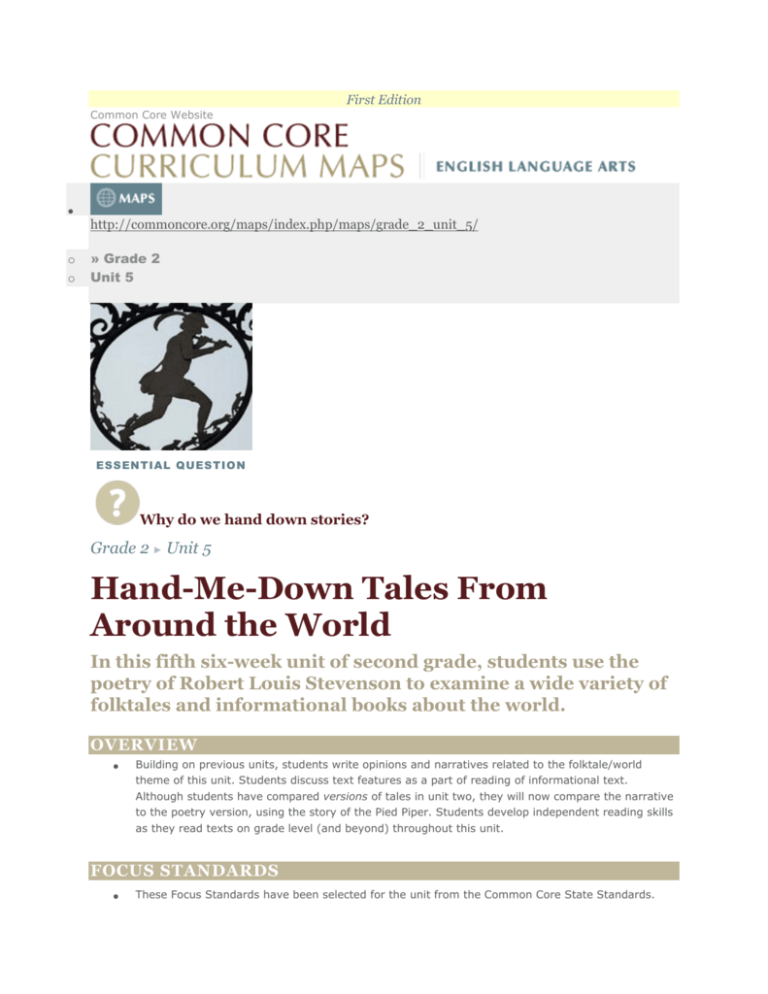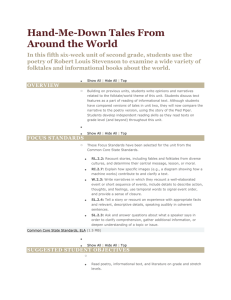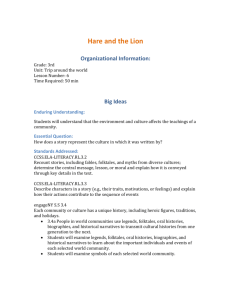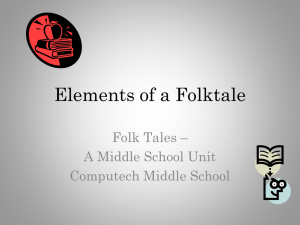
First Edition
Common Core Website
o
o
http://commoncore.org/maps/index.php/maps/grade_2_unit_5/
» Grade 2
Unit 5
ESSENTIAL QUESTION
Why do we hand down stories?
Grade 2 ► Unit 5
Hand-Me-Down Tales From
Around the World
In this fifth six-week unit of second grade, students use the
poetry of Robert Louis Stevenson to examine a wide variety of
folktales and informational books about the world.
OVERVIEW
Building on previous units, students write opinions and narratives related to the folktale/world
theme of this unit. Students discuss text features as a part of reading of informational text.
Although students have compared versions of tales in unit two, they will now compare the narrative
to the poetry version, using the story of the Pied Piper. Students develop independent reading skills
as they read texts on grade level (and beyond) throughout this unit.
FOCUS STANDARDS
These Focus Standards have been selected for the unit from the Common Core State Standards.
o
RL.2.2: Recount stories, including fables and folktales from diverse cultures, and determine
their central message, lesson, or moral.
o
RI.2.7: Explain how specific images (e.g., a diagram showing how a machine works)
contribute to and clarify a text.
o
W.2.3: Write narratives in which they recount a well-elaborated event or short sequence of
events, include details to describe action, thoughts, and feelings, use temporal words to
signal event order, and provide a sense of closure.
o
SL.2.4: Tell a story or recount an experience with appropriate facts and relevant,
descriptive details, speaking audibly in coherent sentences.
o
SL.2.3: Ask and answer questions about what a speaker says in order to clarify
comprehension, gather additional information, or deepen understanding of a topic or issue.
Common Core State Standards, ELA (1.5 MB)
SUGGESTED STUDENT OBJECTIVES
Read poetry, informational text, and literature on grade and stretch levels.
Retell folktales from diverse cultures, determining their central message or lesson.
Write imaginary narratives in which they tell a well-elaborated story based on the study of various
countries.
Ask and answer questions of a speaker who reads a folktale from her home country.
Use text features in non-fiction to aid comprehension of the text.
Compare a variety of versions of Stone Soup, contrasting the differences in story elements and key
details.
Compare a poetry version and a prose version of the same Pied Piper legend.
Learn the irregular forms of plural nouns.
Write an opinion piece on why folktales were handed down.
Memorize a Robert Louis Stevenson poem and record it.
SUGGESTED WORKS
(E) indicates a CCSS exemplar text; (EA) indicates a text from a writer with other works identified
as exemplars.
LITERARY TEXTS
Stories
The Treasure (Uri Shulevitz) (E)
Itching and Twitching: A Nigerian Folktale (Patricia C. and Robert L. McKissack, and Laura Freeman)
The Girl Who Wore Too Much: A Folktale from Thailand (Margaret Read McDonald andYvonne
Lebrun Davis)
Caps for Sale: A Tale of a Peddler (Esphyr Slobodkina)
The Enormous Turnip (Alexei Tolstoy and Scott Goto)
Liang and the Magic Paintbrush (Demi)
Stone Soup (Ann McGovern and Winslow Pinney Pels)
Cuckoo/Cucú: A Mexican Folktale (Lois Ehlert and Gloria de Aragon Andujar)
Moon Rope/Un lazo a la luna: A Peruvian Folktale (Lois Ehlert and Amy Prince)
Poems
“The Land of Counterpane” (Robert Louis Stevenson)
“Foreign Lands” (Robert Louis Stevenson)
“The Land of Story Books” (Robert Louis Stevenson)
“At the Seaside”(Robert Louis Stevenson)
“Where Go the Boats” (Robert Louis Stevenson)
“My Bed is a Boat” (Robert Louis Stevenson)
Stories (Read Aloud)
The 13 Clocks (James Thurber and Marc Simont) (E)
Martina the Beautiful Cochroach, A Cuban Folktale (Carmen Agra Deedy and Michael Austin) (EA)
“How the Camel Got His Hump” in Just So Stories (Rudyard Kipling) (E)
The Village of Round and Square Houses (Ann Grifalconi)
The Lost Horse: A Chinese Folktale (Ed Young and Tracey Adams) (EA)
The Five Chinese Brothers (Claire Huchet Bishop and Kurt Wiese)
Not One Damsel In Distress: World Folktales for Strong Girls (Jane Yolen and Susan Guevara)
The Pied Piper (Steven Kellogg)
Stone Soup (Marcia Brown)
Stone Soup (Jon. J. Muth)
The Real Story of Stone Soup (Ying Chang Compestine)
Stone Soup (Tony Ross)
Some Friends to Feed: The Story of Stone Soup (Pete Seeger, Paul Dubois, and Michael Hays)
Stone Soup (Heather Forest)
Bone Button Borscht (Aubrey Davis and Dušan Petričić)
Poems (Read Aloud)
“The Pied Piper of Hamelin” (Robert Browning) (E)
INFORMATIONAL TEXTS
Informational Text
Art Around the World (Discovery World) (Heather Leonard) (E)
Shoes, Shoes, Shoes (Around the World Series) (Ann Morris)
Weddings (Around the World Series) (Ann Morris)
On the Go (Around the World Series) (Ann Morris and Ken Heyman)
Loving (Around the World Series) (Ann Morris and Ken Heyman)
Bread, Bread, Bread (Around the World Series) (Ann Morris and Ken Heyman)
Houses and Homes (Around the World Series) (Ann Morris and Ken Heyman)
Informational Text (Read Aloud)
If the World Were a Village: A Book about the World’s People (David Smith and Shelagh Armstrong)
(E)
Hungry Planet: What the World Eats (Peter Menzel and Faith D'Aluisio)
How I Learned Geography (Uri Shulevitz) (EA)
ART, MUSIC, AND MEDI A
Music
Film
Sergei Prokofiev, “Peter and the Wolf” (1936)
“Peter and the Wolf,” Suzie Templeton, dir. (2006)
SAMPLE ACTIVITIES AND ASSESSMENTS
Class Discussion / Poetry
Introduce the unit by asking students about using their imaginations to go places. Introduce a poet who
lived over 100 years ago and also loved to go places in his imagination: Robert Louis Stevenson. As a child,
he was sometimes sick. While confined to his bed, he created imaginary lands in his head, such as, “The
Land of Counterpane.” He also loved the sea. As students read his poems, have them think about his
imagination and how he loved to wonder about the world. (You may want to read and reread his poetry
throughout this unit, encouraging the students to look for poetic elements. Most of all, direct children to
enjoy the idea of going places in their minds as you read folktales from around the world. Having a large
world map to mark the place from which the story comes will make this unit have a stronger geography
focus.) (RL.2.4)
Class Discussion / Poetry
Introduce the poem “The Pied Piper of Hamelin” by Robert Browning. This poem is a narrative based on a
legend that is thought to have happened in Hamelin, Germany. Remind students that a legend is a story in
which some things really happened and other things have been exaggerated over time as the story was
passed down through generations. Read the poem to the children. Give the children an opportunity to retell
the story, confirming that they understood the main events of the story. (The language in this poem is quite
sophisticated. Reading the Kellogg book first will scaffold student comprehension of the poem. It will also
provide another opportunity to compare versions.)
Ask questions such as:
How many of you think this story could have really happened?
What was the story teaching? (RL.2.2, SL.2.4. L.2.4a )
Language Activity
After reading “The Pied Piper of Hamelin,” do a word activity based on the poem. Collect some plural nouns
from the poem. Talk about the singular for each word and how it is made plural (e.g., rats, babies, vats,
children, tongues, shoes, and mice). Extend this activity by especially collecting the plurals of irregular
nouns. (L.2.1b)
Class Discussion / Literature
Invite speakers to read folktales from home countries. For example, invite someone from Cuba or the
Caribbean to read Martina the Beautiful Cochroach: A Cuban Folktale(Carmen Agra Deedy). As the vistor
reads the story, have students consider what message the folktale might teach. When the story is over, the
speaker could share some information about the country from which the folktale comes. Give an opportunity
for students to ask questions about the folktale and the country. (SL.2.3, RL.2.2)
Class Discussion / Literature
Read the book, Stone Soup (Marcia Brown), aloud to the students. Introduce other versions of the book
(e.g. Muth, Seeger, Davis). Compare and contrast the versions of the story, using a teacher-created graphic
organizer that addresses “who, what, where, why, when, how” questions or a graphic organizer that
addresses “character, setting, plot, conclusion” categories. Encourage student participation by handing each
child three Post-Its to use to post information on the graphic organizers. (RL.2.2, RL.2.9)
Literary Response
Have students select a folktale to read. Provide each student with a piece of plain white paper. Then, give
these instructions to the children:
“Read a folktale with a partner (a stronger reader could read to a weaker reader, or they could take turns,
or read chorally). When you are finished reading the folktale, follow these directions:
Fold your paper into fourths.
Draw a picture of the main characters in one square.
Draw the setting in another square.
Draw your favorite part of the plot in another square.
In the last part, write a few sentences describing what you think the folktale is teaching.
Each time the students do this activity, substitute one more square with writing instead of drawing. As a
student reads the last book independently, have them use the four-square outline to write a retelling of the
folktale. (RL.2.2, RL.2.5, RL.2.7, RL.2.10, W.2.7, SL.2.2)
Class Discussion / Informational Text
The informational books in this unit are based on a theme like “shoes” or “bread.” For example, the author
of these books, Ann Morris, studied, interesting shoes from all around the world, had photographs taken of
them, and then published them in a book, Shoes, Shoes, Shoes. As students read the books, ask them to
look at the way the book is organized and locate the information about each photograph by using the index.
As they study the book, challenge them to find the location on a world map from where those shoes came.
To link to geography, give each pair of students a world map to mark as the text moves from one place to
another. (After the students have had an opportunity to study multiple books in this series, ask them why
they think the author wrote these books for children.) (RI.2.5, RI.2.10, RI.2.6)
Class Discussion / Informational Text
If the World Were a Village: A Book about the World’s People(David Smith) is an informational book packed
with rich facts about the world. One of the interesting things about this book is that it shows the world as if
it were a village of just 100 people. Although you may have time for just a few pages, focus on how much
information can be learned from the illustrations and text. Keep a list of the information that the students
glean from the pages as you read. (RI.2.3, RI.2.6, RI.2.7)
Narrative Writing
Give the students this prompt: “Write an imaginary narrative telling about a time you passed through a
mysterious door and ended up in a different country. The country may be from our folktale unit, from a book
you have read, or just a place you want to visit. Be sure to say where you find the door, the country where
the door leads, and how you arrive back where you began. Include details to describe action, thoughts, and
feelings. Be sure to end your story well, thinking about how authors wrap up stories.” (W.2.3, L.2.2a)
Art Appreciation
Explain to the students that Sergei Prokofiev is a Russian musical composer who wrote a musical rendition
of the folktale called “Peter and the Wolf.” Explain that he used different musical instruments to represent
the characters in the story. Compare and contrast different productions of this piece (e.g., animated version,
music-only CD, video of the ballet). (RL.2.2, RL.2.6, RL.2.9, SL.2.2)
Dramatization / Fluency
Revisit the Robert Louis Stevenson poetry, reminding students how they have used their imaginations to
visualize the folktale being read and the places being read about (see the first “Class Discussion / Poetry”
activity). Discuss how repeated readings may deepen a poem’s meaning, and challenge the students to
memorize one of the poems to share in front of the class. Record the students’ poetry performances with a
video camera. (RL.2.4, SL.2.5)
Literature / Opinion-Writing
Give the students this prompt:“All of the stories we read in this unit were folktales of some kind. Why do
you think stories are handed down from one group of people to another? Be sure to support your opinion
with strong reasons.” (W.2.1)
ADDITIONAL RESOURCES
A Collection of Folktales from Around the World (Oak Terrace Elementary School, Highwood, IL) (RL
2.2)
TERMINOLOGY
character
conclusion
folktale
index
irregular
legend
narrative poem
noun
plot
plural
setting
MAKING INTERDISCIPLINARY CONNECTIONS
This unit teaches:
o
Music: Prokofiev
o
History & Geography: World geography (e.g., places of origin for folk tales: Nigeria,
Thailand, Mexico, Peru, etc.; cultural comparisons)
This unit could be extended to teach:
History & Geography: (e.g., E Pluribus Unum, Ellis Island, etc.)
© 2011 Common Core, Inc. All rights reserved. • Contact Us












